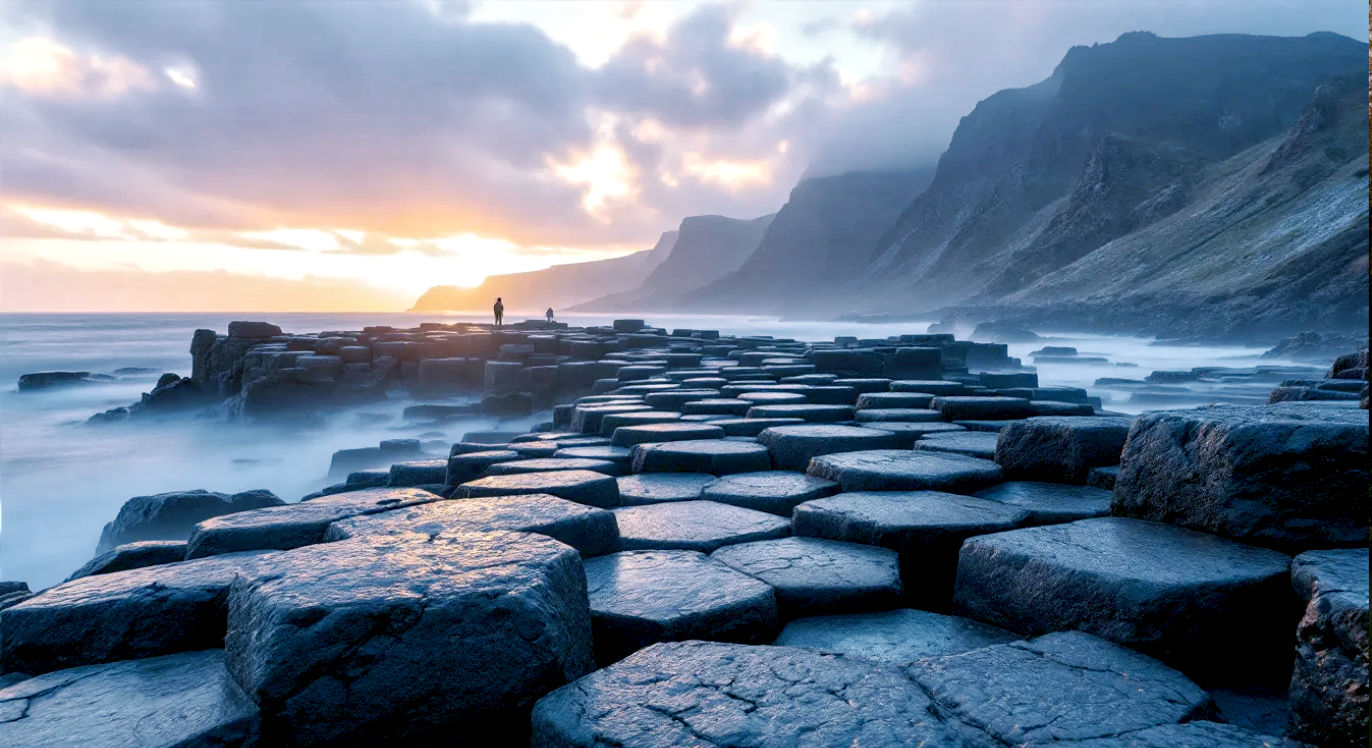Giant’s Causeway: Unveiling Northern Ireland’s Natural Sculptures
Explore Northern Ireland’s only UNESCO World Heritage site. Uncover the story of its 40,000 basalt columns, from fiery origins to giant legends.

This post may contain affiliate links. If you make a purchase through these links, we may earn a commission at no additional cost to you.
Picture this: you’re standing on the rugged coast of Northern Ireland, the wild Atlantic wind whipping at your coat. At your feet, a sight so strange, so perfectly geometric, it feels like it must have been made by hands. Thousands of stone columns, mostly perfect hexagons, fit together like a giant honeycomb, stepping down from the cliffs and disappearing into the crashing waves. This isn’t a film set or a modern art installation. This is the Giant’s Causeway.
For centuries, this mind-boggling landscape has sparked wonder. Is it the work of a mythical giant, a fiery-tempered warrior named Finn MacCool? Or is it the result of a colossal volcanic eruption, a story of fire and ice from the dawn of time? The truth, as you’ll discover, is just as magical as the myth.
This isn’t just a pile of rocks; it’s a UNESCO World Heritage site, a national nature reserve, and a true icon of the British Isles. It’s a place where science and legend collide, where you can walk in the footsteps of giants and touch a piece of Earth’s ancient past. So, let’s peel back the layers of this incredible place, from its explosive beginnings to the folklore that gives it its soul. We’ll explore how it was formed, who ‘discovered’ it, and what makes it one of the most treasured natural wonders on our shores.
What on Earth is the Giant’s Causeway? The Science Behind the Stones
At first glance, the Causeway looks completely unnatural. The columns are so neat and orderly, you’d be forgiven for thinking a master stonemason had been at work. But this incredible structure is 100% natural, forged by the immense power of our planet around 60 million years ago. To understand how, we need to go back to a time when Northern Ireland was a hotbed of volcanic activity.
A Fiery Beginning: The Antrim Lava Flows
Long before humans walked the Earth, this part of the world was literally tearing itself apart. The supercontinent of Laurasia was splitting, pulling what would become Europe and North America away from each other. This wasn’t a gentle process. The Earth’s crust stretched and thinned, allowing molten rock, or magma, to burst through from deep within the mantle.
This created a massive volcanic plateau. Wave after wave of fiery, runny basalt lava poured out across the land, covering what is now County Antrim. This wasn’t a single eruption but a series of flows over thousands of years. Think of it like pouring layer upon layer of treacle, with each new flow covering the last. At the Giant’s Causeway, you can still see these distinct layers in the cliffs, like a geological cake. The oldest layers are at the bottom, with the youngest at the top. The Causeway itself formed from one of these middle layers.
The Magic of Cooling: How the Columns Formed
So, we have a vast, thick lake of molten lava. What happens next is the real magic, and it’s all down to a bit of simple physics—the same principle you see in drying mud.
As the lava began to cool, it started to shrink. The top surface, exposed to the cooler air and sea, cooled the fastest, while the bottom of the flow stayed hotter for longer. This difference in temperature created stress in the rock. As the lava contracted, cracks began to form on the surface, just like cracks appearing in a muddy puddle as it dries out in the sun.
Now, here’s the clever bit. Nature is very efficient; it doesn’t like to waste energy. The most stable and efficient way for these cracks to spread downwards through the cooling lava was in a hexagonal pattern. These cracks, known as columnar joints, grew down through the lava flow as it cooled from the top down and the bottom up. Where the cooling was perfectly even, beautiful, six-sided columns were formed.
Not all the columns are perfect hexagons, though. If you look closely, you’ll find columns with four, five, seven, or even eight sides. This happened where the cooling was slightly less uniform. In total, there are around 40,000 of these interlocking basalt columns. It’s a stunning example of natural geometry on a colossal scale.
A Closer Look at the Rock
The rock itself is called basalt. It’s a dark, fine-grained volcanic rock that’s rich in iron and magnesium. When it first erupted, it would have been glowing red-hot, at temperatures over 1,000°C. As it cooled, it became the hard, dark grey rock you see today. Some of the columns have a reddish tint. This isn’t rust from the sea; it’s baked-in. This colour comes from laterite, a type of ancient, iron-rich soil that was baked and altered by the heat of the lava flows on top of it. You can see a prominent red band of it in the cliffs, separating different lava flows.
So, while the myth of a giant is a fantastic story, the scientific explanation is arguably just as awe-inspiring: a tale of continents splitting, volcanoes erupting, and the slow, perfect cooling of rock over millennia.
The Legend of Finn MacCool: A Tale of Two Giants
Of course, science can’t have all the fun. For centuries before geologists figured out the truth, people in Ireland had their own explanation for this bizarre landscape. It wasn’t made by volcanoes; it was built by a giant.
The story belongs to Finn MacCool (or Fionn mac Cumhaill in Irish mythology), the legendary hero and leader of a band of warriors called the Fianna. Finn was a giant of a man, with a big heart and an even bigger temper. He lived a happy life on the Antrim coast until he heard of a rival giant across the sea in Scotland.
The Feud with Benandonner
This Scottish giant was named Benandonner, also known as the Red Man. He was a fearsome brute who would shout insults at Finn from across the water. One day, Finn had had enough. “I’ll teach him a lesson!” he roared. But there was a problem: there was no boat big enough to carry him to Scotland.
Not one to be beaten, Finn decided to build his own bridge. He ripped huge chunks of rock from the cliffs, hammering them into the seabed to create a causeway that would stretch all the way to Scotland. He worked for days, tirelessly building his path to battle. When it was finished, he stood back, proud of his work, and shouted across the sea, “Right, Benandonner, come and face me if you dare!”
He then lay down for a quick nap before the fight, exhausted from his efforts.
A Cunning Plan
Meanwhile, Benandonner saw the finished causeway and started to stride across it. As he got closer to the Irish shore, Finn’s wife, Oonagh, saw him coming. Her heart sank. Benandonner was enormous, far bigger and uglier than she had ever imagined. He would surely crush Finn!
Thinking fast, she ran to her sleeping husband. But Finn was so tired he wouldn’t wake up. In a moment of genius, Oonagh grabbed a baby’s bonnet and a blanket, quickly dressing the sleeping Finn up as a giant baby and tucking him into a makeshift cradle.
Just then, Benandonner burst into their home, bellowing, “Where is this Finn MacCool? I’m here to thrash him!”
Oonagh put a finger to her lips. “Shhh!” she whispered, “You’ll wake the baby.”
Benandonner peered into the cradle. He saw the huge ‘baby’ lying there and his blood ran cold. If that was the size of Finn’s baby, he thought, how terrifyingly massive must the father be? He didn’t wait to find out. Terrified, he turned and fled back across the causeway.
To make sure Finn couldn’t follow him, he smashed up the path as he went, leaving only the remnants we see today at the Giant’s Causeway in Northern Ireland and on the Scottish island of Staffa, where similar columns are found at Fingal’s Cave. And that, so the story goes, is how the Causeway got its name.
More Than Just a Story
This legend is more than just a fairy tale. It’s a powerful piece of shared culture that connects Northern Ireland and Scotland. The geological features are so similar because they were, in fact, formed by the same ancient lava flow. The story of Finn MacCool is a wonderful, human way of explaining a profound geological connection. It has been passed down through generations and remains a huge part of the Causeway’s identity.
A Journey Through Time: The History of the Causeway
While the Causeway’s geological and mythical origins are ancient, its story in human history is much more recent. For most of its existence, it was simply a local landmark on a remote and wild coastline, known only to the people who lived there. Its journey to becoming a world-famous tourist destination is a fascinating one.
The ‘Discovery’ and Early Tourism
The world beyond the Antrim coast first learned about the Causeway in 1692. The man credited with its ‘discovery’ was the Bishop of Derry, who shared his findings with learned societies in Dublin and London. However, it was a Dublin artist, Susanna Drury, who really put it on the map. In 1739, she painted a series of watercolours of the Causeway. These were later made into engravings and distributed widely, captivating the public imagination across Europe.
Suddenly, this strange place became a must-see for wealthy adventurers on their Grand Tour. Early tourism was a rough-and-tumble affair. There were no visitor centres or safety rails. Visitors would arrive by boat or on horseback, guided by local people who would share the legend of Finn MacCool and sell them souvenirs. These guides became a famous part of the Causeway experience, known for their wit and storytelling.
The Tramway and the Rise of Mass Tourism
The biggest change came in the Victorian era. The Giant’s Causeway Tramway, which opened in 1883, was a pioneering hydroelectric tramway that ran from Portrush right to the stones. This made it far easier for ordinary people to visit. For the first time, the Causeway was accessible not just to the wealthy but to the growing middle class.
This boom in tourism led to fierce competition. Rival hotels were built, and different families claimed to be the ‘official’ guides, sometimes leading to arguments right in front of the tourists! The Causeway was becoming a business.
Protection and World Heritage Status
As the 20th century progressed, there was a growing recognition that the Causeway needed to be protected. The site was gifted to the National Trust in 1961, ensuring it would be preserved for the nation. This was a crucial step in managing the site sustainably and protecting its delicate geology and wildlife.
The ultimate recognition of its global importance came in 1986, when UNESCO awarded the Giant’s Causeway and Causeway Coast World Heritage Status. It was the first and only site in Northern Ireland to receive this honour. This placed it alongside wonders like the Pyramids of Giza and the Great Wall of China as a place of “outstanding universal value.”
Today, the Causeway is Northern Ireland’s most popular tourist attraction, drawing over a million visitors each year. The state-of-the-art Visitor Centre, which opened in 2012, is cleverly built into the landscape and tells the story of the Causeway using interactive exhibits. From a remote, mythical headland, it has become a true global icon.
Exploring the Causeway: A Visitor’s Guide
A visit to the Giant’s Causeway is an unforgettable experience, but a little planning goes a long way. Knowing what to see, what to wear, and how to get around will help you make the most of your trip to this spectacular corner of the British Isles.
The Main Sights: More Than Just Columns
While the main cluster of hexagonal columns is the star of the show, there’s a lot more to explore. The site is dotted with fascinating rock formations, each with its own name and story, often linked to the legend of Finn MacCool.
- The Grand Causeway: This is the largest and most famous section, where the columns form a wide, stepping-stone path into the sea. This is the part of Finn’s bridge that Benandonner left behind. It’s the perfect spot for photos, but be mindful that the stones can be slippery when wet.
- The Giant’s Boot: Along the path down to the main Causeway, look out for a large, boot-shaped rock. Legend says this was a boot lost by Finn MacCool as he fled from the giant Benandonner. Geologists say it’s just a particularly well-weathered boulder, but you can decide which story you prefer!
- The Wishing Chair: This is a natural throne formed from a perfectly smooth and curved set of columns. For generations, visitors have sat in the chair to make a wish. It’s said that if you sit and think of your heart’s desire, it might just come true.
- The Chimney Stacks: Standing high on the headland, these isolated stacks of basalt columns look like the chimneys of a giant’s cottage. They are actually remnants of a lava flow that have been weathered and eroded over time, leaving these tall pillars standing alone.
- The Organ: Further along the coast, you’ll find a set of tall, straight columns built into the cliff face, perfectly resembling the pipes of a massive church organ. It’s one of the most striking examples of the Causeway’s geometric beauty.
Walking Trails and Getting Around
The best way to experience the Causeway is on foot. There are several walking trails to suit different fitness levels, all offering stunning views of the coastline.
- The Blue Trail (Accessible Route): This is the most direct route. It’s a tarmacked path that runs for just under a mile from the Visitor Centre down to the stones. It’s suitable for wheelchairs and pushchairs. There is also a regular, accessible bus service that runs up and down this path for a small fee.
- The Red Trail (Coastal Path): For the more adventurous, this trail offers breathtaking clifftop views. You walk along the top of the cliffs, looking down on the Causeway, before descending a set of steep steps (known as the Shepherd’s Steps) to the stones themselves. The full loop is about 2 miles and is not for the faint of heart, but the views are your reward.
- The Runkerry Trail: This longer route (around 2 miles each way) takes you west from the Causeway towards the beautiful Runkerry beach. It’s a great way to escape the crowds and enjoy the wider coastal scenery.
Practical Tips for Your Visit
- Book in Advance: To guarantee entry, especially during peak season (summer and school holidays), it’s essential to book your tickets online through the National Trust website.
- Wear Sensible Shoes: The paths can be steep, and the stones themselves are uneven and can be very slippery, especially when wet. Sturdy walking shoes or trainers with good grip are a must.
- Dress for the Weather: The Antrim coast is famous for having four seasons in one day. Even on a sunny day, the wind can be strong. It’s wise to bring layers and a waterproof jacket, just in case.
- Listen to the Audio Guide: Included with your ticket, the audio guide is excellent. It brings the stories and science of the Causeway to life as you walk around. You can pick one up at the Visitor Centre.
- Respect the Site: The Giant’s Causeway is a precious natural wonder. Stick to the marked paths, don’t climb on fragile formations, and take all your litter home with you. Help the National Trust keep it special for generations to come.
The Causeway’s Legacy: Nature, Culture, and the Future
The Giant’s Causeway is more than just a tourist attraction; it’s a vital part of Northern Ireland’s identity and a precious natural habitat. Its influence is felt in local culture, the economy, and the ongoing work to protect our planet’s most special places.
A Haven for Wildlife
While the dramatic geology takes centre stage, the Causeway coast is also a haven for nature. The cliffs are home to thousands of nesting seabirds, including fulmars, kittiwakes, and razorbills. Look closely, and you might even spot a puffin during the spring and summer months.
The sea around the Causeway is rich with life too. Look out for dolphins and porpoises playing in the waves. On a calm day, you might even see a grey seal popping its head above the water.
The grasslands on the clifftops are also special. They are home to a variety of rare wildflowers that have adapted to the harsh, salty conditions. The National Trust works hard to manage these habitats, balancing the needs of visitors with the protection of this unique ecosystem.
Cultural and Economic Impact
The Causeway is the jewel in the crown of Northern Ireland’s tourism industry. It brings visitors and money to the local area, supporting jobs in hotels, restaurants, and shops. It has put this corner of the UK on the global map, inspiring artists, writers, and filmmakers for generations.
It has also become a powerful symbol of Northern Ireland itself: rugged, beautiful, and with a story to tell. For many people, it represents a connection to a deep, shared heritage that goes beyond politics and history—a heritage written in stone.
The Challenges Ahead: Conservation in a Changing World
Protecting a site like the Giant’s Causeway is a huge responsibility. One of the biggest challenges is managing the sheer number of visitors. The National Trust has to carefully balance providing a world-class experience with preventing damage to the site. The creation of the new Visitor Centre, which is almost invisible from the coastline, was a major step in managing this pressure.
But the biggest threat of all is climate change. Rising sea levels and more frequent, powerful storms pose a direct threat to the Causeway’s columns. The constant battering from the Atlantic waves is a natural process of erosion, but climate change is speeding it up.
The work to monitor and understand these changes is ongoing. Scientists are studying how the coastline is evolving to predict what might happen in the future. Protecting the Giant’s Causeway isn’t just about preserving the past; it’s about safeguarding this incredible wonder for the future in a rapidly changing world. It’s a local challenge with global significance, reminding us that even the strongest giants need our help.
Further Reading & Resources
To continue your exploration of this fascinating topic, here are some highly respected resources:
- National Trust – Giant’s Causeway: The official site with the most up-to-date visitor information, booking details, and conservation news. https://www.nationaltrust.org.uk/giants-causeway
- UNESCO World Heritage Centre – Giant’s Causeway: The official listing and description of the site’s “outstanding universal value.” https://whc.unesco.org/en/list/369
- Geological Survey of Northern Ireland: For a deeper dive into the science behind the Causeway and the geology of the region. https://www.bgs.ac.uk/geology-projects/gsni/
- Discover Northern Ireland – Causeway Coastal Route: The official tourism website, great for planning a wider trip along this stunning coastline. https://discovernorthernireland.com/things-to-do/causeway-coastal-route






